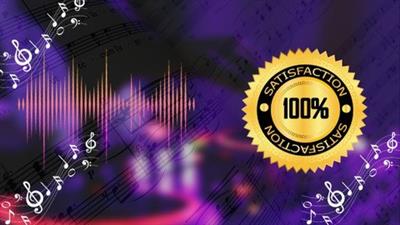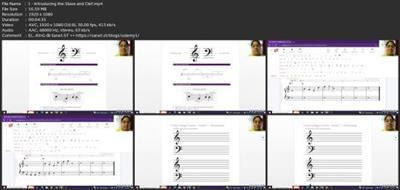
Learn Music Theory From Scratch-Tcl Grade 1 Exam Prep. 100%
Published 11/2023
MP4 | Video: h264, 1920x1080 | Audio: AAC, 44.1 KHz
Language: English | Size: 2.00 GB | Duration: 4h 16m
This course is based on the Trinity College London - Grade 1 Music theory syllabus and Basic Sight Reading (Practical)
What you'll learn
Understanding Basic Music Theory - Rhythm, Pitch, Musical Words and Symbols
Understanding Basic Sight Reading - Piano
Trinity College London - Grade 1 Sample Papers - Discussion
Trinity College London Grade 1 Music Theory Exam Preparation
Requirements
No Music theory or practical knowledge needed. Worksheets and Short notes will be provided.
Description
Learn how artists compose musicWhat is the importance of learning Music Theory? Learning music theory allows musicians to recognize patterns in music and become fluent readers of notated music. By understanding the structure and form of the music they're performing, they can access harmonic memory and recount large sections of music from memory. Improve improvisational skills. The basic elements of Music Theory includes melody, rhythm, harmony, form, pitch, and scales. We will be covering all those in this lesson except FORM. I'll be helping you through out until your exam (if you're willing to sit) and you can contact me anytime. It doesn't matter whether you're old or young, TCL exams can be done by anyone. Recognition of TCL: Trinity College London is an international exam board regulated by Ofqual (Office of Qualifications and Examinations Regulation) in England, CCEA (Council for the Curriculum, Examinations and Assessment) in Northern Ireland and by Qualifications Wales. Trinity's graded music exams and music diplomas are regulated by these authorities within the Regulated Qualifications Framework (RQF). Various arrangements are in place with governmental education authorities worldwide. This is a great opportunity for you to learn the accredited TCL syllabus and basic practical on piano (Sight Reading). Don't miss out! Purchase the course today.
Overview
Section 1: Rhythm
Lecture 1 Introducing the Stave and Clef
Lecture 2 Treble and Bass stave
Lecture 3 Notes and Stems
Lecture 4 Lines and Spaces of the Treble clef
Lecture 5 Bass Clef - lines and spaces
Lecture 6 Bass Clef lines and spaces and Ledger lines
Lecture 7 Middle C on the Piano
Section 2: Piano Keyboard
Lecture 8 Identifying the white keys of a keyboard
Lecture 9 Piano Keyboard Quiz
Section 3: Note Values and Rests
Lecture 10 Note Value
Lecture 11 Rests
Lecture 12 Rest Work sheet
Lecture 13 Dotted Minim
Section 4: Bars, Bar lines and Time Signatures
Lecture 14 Time Signatures - 2/4, 3/4, 4/4
Lecture 15 Bar lines work sheet
Section 5: Sight Reading - Piano
Lecture 16 How to play note values
Lecture 17 Sight Reading (Part 1)
Lecture 18 Sight Reading (Part 2)
Lecture 19 Sight Reading (Part 3)
Lecture 20 Sight Reading (Part 4)
Lecture 21 Sight Reading (Part 5)
Section 6: Tone, Semitones and Accidentals
Lecture 22 Tone and Semitone
Lecture 23 Accidentals
Lecture 24 How to write the accidentals and the importance
Lecture 25 How to Write the accidentals
Lecture 26 Accidentals work sheet
Section 7: Keys and Tonic Triads
Lecture 27 C Major
Lecture 28 Triads on the keyboard
Lecture 29 The Tonic Triad in the key of C Major
Lecture 30 Roman Numerals and Chord Symbols
Lecture 31 Key signatures on the keyboard
Lecture 32 F Major Scale
Lecture 33 C Major Scale on the keyboard
Lecture 34 G Major scale on the keyboard
Lecture 35 Key Signatures
Lecture 36 Key Signatures and work sheet (2)
Lecture 37 The Circle of 5ths
Lecture 38 F Major and G Major scale work sheet
Lecture 39 F Major and G Major scales
Section 8: Intervals
Lecture 40 Intervals
Lecture 41 Intervals work sheet
Section 9: Arpeggios
Lecture 42 Arpeggios
Lecture 43 Arpeggios work sheet
Lecture 44 Arpeggios on the keyboard
Lecture 45 Arpeggios on the Keyboard - F Major and G Major Arpeggios
Lecture 46 Difference between Chord( (Triad) and Melody
Section 10: Grouping Notes and Rests
Lecture 47 Grouping Notes and Beaming Quavers
Lecture 48 Grouping Rests
Lecture 49 Grouping work sheet
Lecture 50 Whole Bar of Silence
Section 11: Answering a given Rhythm
Lecture 51 Answering a given Rhythm
Lecture 52 Ostinato
Lecture 53 Ostinato Worksheet
Lecture 54 Ostinato work sheet - part 2
Section 12: Musical words and symbols
Lecture 55 Dynamics
Lecture 56 Articulations
Section 13: Analysis
Lecture 57 Analysis
Section 14: Practice tests
Lecture 58 Message from the tutor
Lecture 59 May 2013 (A) Paper Answers
Lecture 60 Guildhall Sample Paper - Answers
Section 15: Trinity College London Exam - How to register?
Lecture 61 Last Words from the Tutor
Anyone who is curious to learn basic Music Theory / Anyone who likes to do the basic TCL theory Exam.
Screenshots

download скачать link
rapidgator.net:
https://rapidgator.net/file/e958ef3373733248ccb86e2bf5a62673/xzzsm.Learn.Music.Theory.From.ScratchTcl.Grade.1.Exam.Prep..100.part1.rar.html https://rapidgator.net/file/1300f3de30c33b6f70a69216c4bdd6a4/xzzsm.Learn.Music.Theory.From.ScratchTcl.Grade.1.Exam.Prep..100.part2.rar.html https://rapidgator.net/file/b41f295990a89510934e53a3d3a8c2ec/xzzsm.Learn.Music.Theory.From.ScratchTcl.Grade.1.Exam.Prep..100.part3.rar.html
uploadgig.com:
https://uploadgig.com/file/download скачать/f3653c3382514021/xzzsm.Learn.Music.Theory.From.ScratchTcl.Grade.1.Exam.Prep..100.part1.rar https://uploadgig.com/file/download скачать/07a4084dA4bB0d63/xzzsm.Learn.Music.Theory.From.ScratchTcl.Grade.1.Exam.Prep..100.part2.rar https://uploadgig.com/file/download скачать/d382f7A48ec07195/xzzsm.Learn.Music.Theory.From.ScratchTcl.Grade.1.Exam.Prep..100.part3.rar

